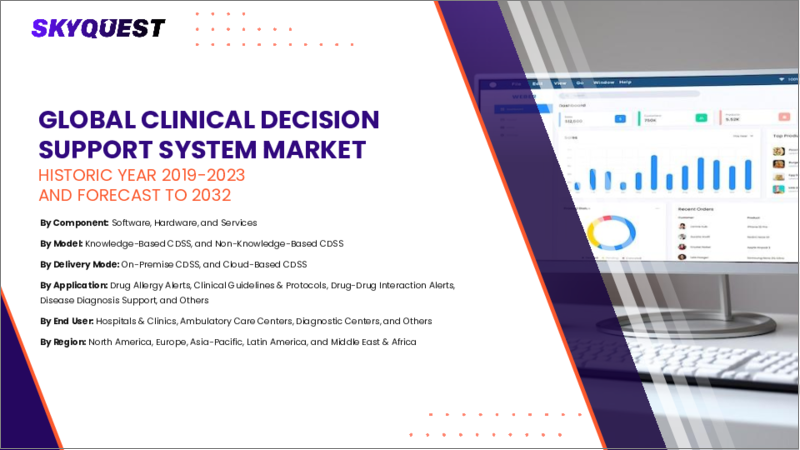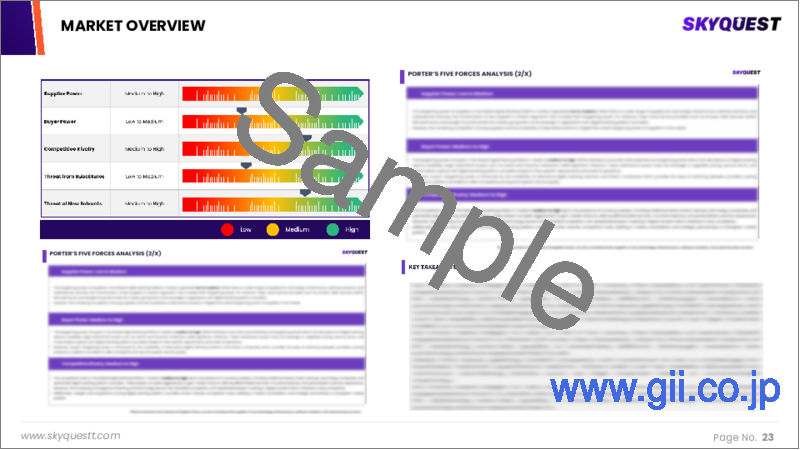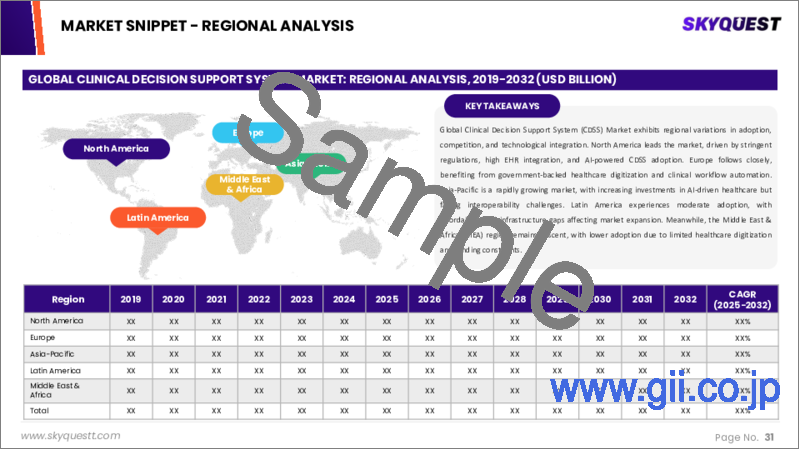|
|
市場調査レポート
商品コード
1646181
臨床意思決定支援システムの市場規模、シェア、成長分析:コンポーネント別、製品別、タイプ別、モデル別、配送方法別、用途別、対話レベル別、環境別、地域別 - 産業予測、2025年~2032年Clinical Decision Support System Market Size, Share, Growth Analysis, By Component, By Product, By Type, By Model, By Delivery Mode, By Application, By Interactivity Level, By Setting, By Region - Industry Forecast 2025-2032 |
||||||
|
|||||||
| 臨床意思決定支援システムの市場規模、シェア、成長分析:コンポーネント別、製品別、タイプ別、モデル別、配送方法別、用途別、対話レベル別、環境別、地域別 - 産業予測、2025年~2032年 |
|
出版日: 2025年01月26日
発行: SkyQuest
ページ情報: 英文 260 Pages
納期: 3~5営業日
|
全表示
- 概要
- 目次
臨床意思決定支援システム(CDSS)の市場規模は2023年に21億米ドルで、2024年の22億6,000万米ドルから2032年には40億9,000万米ドルに成長し、予測期間(2025-2032年)のCAGRは7.7%で成長する見通しです。
臨床意思決定支援システム(CDSS)市場は、質の高いヘルスケアに統合された信頼性の高い技術ソリューションに対する需要の高まりによって大きな成長を遂げています。この成長は、ヘルスケア施設における情報システムの導入や、特に製品の完全性を保証する厳格なFDAおよびCEマーク規制など、世界の政府の支援イニシアティブによって後押しされています。COVID-19の大流行はCDSSの重要性を浮き彫りにしています。CDSSはヘルスケアチームに最新の医学的知見を提供し、圧倒的な患者数の中でケアの質を高めるからです。COvid Risk cALculator(CORAL)のようなイノベーションは、CDSSの電子カルテへの統合の成功例を示しています。さらに、遠隔モニタリングツールや効率的な健康データ伝送のニーズが急増しており、市場関係者はCOVID-19機能でEHR機能を強化するよう促しているため、コネクテッド医療機器の需要がさらに高まっています。
目次
イントロダクション
- 調査の目的
- 調査範囲
- 定義
調査手法
- 情報調達
- 二次データと一次データの方法
- 市場規模予測
- 市場の前提条件と制限
エグゼクティブサマリー
- 世界市場の見通し
- 供給と需要の動向分析
- セグメント別機会分析
市場力学と見通し
- 市場概要
- 市場規模
- 市場力学
- 促進要因と機会
- 抑制要因と課題
- ポーターの分析
主な市場の考察
- 重要成功要因
- 競合の程度
- 主な投資機会
- 市場エコシステム
- 市場の魅力指数(2024年)
- PESTEL分析
- マクロ経済指標
- バリューチェーン分析
- 価格分析
- 顧客と購買基準の分析
- 規制分析
臨床意思決定支援システム市場規模:コンポーネント別& CAGR(2025-2032)
- 市場概要
- サービス
- ソフトウェア
- ハードウェア
臨床意思決定支援システム市場規模:製品別& CAGR(2025-2032)
- 市場概要
- 統合CDSS
- スタンドアロンCDSS
臨床意思決定支援システム市場規模:タイプ別& CAGR(2025-2032)
- 市場概要
- 治療的CDSS
- 診断用CDSS
臨床意思決定支援システム市場規模:モデル別& CAGR(2025-2032)
- 市場概要
- 知識ベースCDSS
- 非知識ベース CDSS
臨床意思決定支援システム市場規模:配送方法別& CAGR(2025-2032)
- 市場概要
- オンプレミス CDSS
- クラウドベースのCDSS
臨床意思決定支援システム市場規模:用途別& CAGR(2025-2032)
- 市場概要
- 従来のCDSS
- 高度なCDSS
臨床意思決定支援システム市場規模:対話レベル別& CAGR(2025-2032)
- 市場概要
- アクティブCDSS
- パッシブCDSS
臨床意思決定支援システム市場規模:環境別& CAGR(2025-2032)
- 市場概要
- 入院患者環境
- 外来診療環境
臨床意思決定支援システム市場規模:地域別& CAGR(2025-2032)
- 北米
- 米国
- カナダ
- 欧州
- ドイツ
- スペイン
- フランス
- 英国
- イタリア
- その他欧州地域
- アジア太平洋地域
- 中国
- インド
- 日本
- 韓国
- その他アジア太平洋地域
- ラテンアメリカ
- ブラジル
- その他ラテンアメリカ地域
- 中東・アフリカ
- GCC諸国
- 南アフリカ
- その他中東・アフリカ
競合情報
- 上位5社の比較
- 主要企業の市場ポジショニング(2024年)
- 主な市場企業が採用した戦略
- 市場の最近の動向
- 企業の市場シェア分析(2024年)
- 主要企業の企業プロファイル
- 会社概要
- 製品ポートフォリオ分析
- セグメント別シェア分析
- 収益の前年比比較(2022-2024)
主要企業プロファイル
- Epic Systems Corporation(United States)
- Oracle(United States)
- Athenahealth(United States)
- Elsevier(division of RELX Group)(Netherlands)
- Koninklijke Philips N.V.(Netherlands)
- Medical Information Technology, Inc.(MEDITECH)(United States)
- CureMD Healthcare(United States)
- EBSCO Information Services(United States)
- GE Healthcare(United States)
- eClinicalWorks, LLC(United States)
- The Medical Algorithms Company Limited(United Kingdom)
- Hera-MI(France)
- RampMedical(Germany)
- VisualDx(United States)
- First Databank, Inc.(FDB)(United States)
- Strata Decision Technology(United States)
- Alcidion(Australia)
結論と推奨事項
Clinical Decision Support System Market size was valued at USD 2.1 billion in 2023 and is poised to grow from USD 2.26 billion in 2024 to USD 4.09 billion by 2032, growing at a CAGR of 7.7% during the forecast period (2025-2032).
The market for clinical decision support systems (CDSS) is experiencing significant growth driven by the rising demand for reliable technical solutions integrated into quality healthcare. This growth is fueled by the implementation of information systems in healthcare facilities and supportive global government initiatives, particularly with stringent FDA and CE Mark regulations ensuring product integrity. The COVID-19 pandemic has underscored the importance of CDSS, as it provides healthcare teams with the latest medical insights, enhancing care quality amidst overwhelming patient volumes. Innovations like the COvid Risk cALculator (CORAL) exemplify successful integrations of CDSS into electronic health records. Furthermore, the need for remote monitoring tools and efficient health data transmission has surged, prompting market players to enhance EHR functionalities with COVID-19 features, thus driving further demand for connected medical devices.
Top-down and bottom-up approaches were used to estimate and validate the size of the Clinical Decision Support System market and to estimate the size of various other dependent submarkets. The research methodology used to estimate the market size includes the following details: The key players in the market were identified through secondary research, and their market shares in the respective regions were determined through primary and secondary research. This entire procedure includes the study of the annual and financial reports of the top market players and extensive interviews for key insights from industry leaders such as CEOs, VPs, directors, and marketing executives. All percentage shares split, and breakdowns were determined using secondary sources and verified through Primary sources. All possible parameters that affect the markets covered in this research study have been accounted for, viewed in extensive detail, verified through primary research, and analyzed to get the final quantitative and qualitative data.
Clinical Decision Support System Market Segments Analysis
Global Clinical Decision Support System Market is segmented by Component, Product, Type, Model, Delivery Mode, Application, Interactivity Level, Setting and region. Based on Component, the market is segmented into Services,Softwareand Hardware. Based on Product, the market is segmented into Integrated CDSS and Standalone CDSS. Based on Type, the market is segmented into Therapeutic CDSS and Diagnostic CDSS. Based on Model, the market is segmented into Knowledge-Based CDSS and Non-Knowledge-Based CDSS. Based on Delivery Mode, the market is segmented into On-Premise CDSS and Cloud-Based CDSS. Based on Application, the market is segmented into Conventional CDSS and Advanced CDSS. Based on Interactivity Level, the market is segmented into Active CDSS and Passive CDSS. Based on Setting, the market is segmented into Inpatient Settings and Ambulatory Care Settings. Based on region, the market is segmented into North America, Europe, Asia Pacific, Latin America and Middle East & Africa.
Driver of the Clinical Decision Support System Market
In 2021, health ministers within the European Union collaborated to establish an eHealth common area, facilitating the seamless exchange of electronic health records across the continent. This initiative emphasizes the integration of eHealth into the Europe 2021 strategy, aiming to enhance healthcare efficiency and interoperability. As a result, the growing emphasis on electronic health records (EHR) is anticipated to drive demand for Clinical Decision Support Systems (CDSS) in significant global markets. The implementation of such policies and initiatives will undoubtedly bolster the adoption of CDSS, ultimately improving patient care by enabling better clinical decision-making through enhanced data accessibility and sharing.
Restraints in the Clinical Decision Support System Market
The global clinical decision support systems market is anticipated to face growth obstacles stemming from healthcare providers' reluctance to implement and maintain these systems. This resistance may be attributed to factors such as high installation costs, concerns about system compatibility, and the need for extensive training for healthcare personnel. Additionally, fears regarding data privacy and the integration of new technologies into existing workflows may further hinder the adoption of clinical decision support systems. As a result, these challenges could significantly impact the overall expansion and effectiveness of such systems in enhancing clinical decision-making processes.
Market Trends of the Clinical Decision Support System Market
The Clinical Decision Support System (CDSS) market is witnessing significant growth driven by increased partnerships between CDSS providers and healthcare institutions. This trend is fueled by government initiatives promoting the integration of CDSS with Electronic Health Records (EHR), aimed at enhancing clinical efficiency and reducing time spent on patient data retrieval. As a result, there has been a notable adoption of CDSS in American hospitals, with approximately 41% having a CDSS integrated with EHR systems in 2021. The U.S. government's financial incentives further boost this trend, encouraging hospitals to implement advanced CDSS technologies. Collaborative efforts among businesses to develop up-to-date software solutions are anticipated to sustain growth in this sector.
Table of Contents
Introduction
- Objectives of the Study
- Scope of the Report
- Definitions
Research Methodology
- Information Procurement
- Secondary & Primary Data Methods
- Market Size Estimation
- Market Assumptions & Limitations
Executive Summary
- Global Market Outlook
- Supply & Demand Trend Analysis
- Segmental Opportunity Analysis
Market Dynamics & Outlook
- Market Overview
- Market Size
- Market Dynamics
- Drivers & Opportunities
- Restraints & Challenges
- Porters Analysis
- Competitive rivalry
- Threat of substitute
- Bargaining power of buyers
- Threat of new entrants
- Bargaining power of suppliers
Key Market Insights
- Key Success Factors
- Degree of Competition
- Top Investment Pockets
- Market Ecosystem
- Market Attractiveness Index, 2024
- PESTEL Analysis
- Macro-Economic Indicators
- Value Chain Analysis
- Pricing Analysis
- Customer And Buying Criteria Analysis
- Regulatory Analysis
Global Clinical Decision Support System Market Size by Component & CAGR (2025-2032)
- Market Overview
- Services
- Software
- Hardware
Global Clinical Decision Support System Market Size by Product & CAGR (2025-2032)
- Market Overview
- Integrated CDSS
- Standalone CDSS
Global Clinical Decision Support System Market Size by Type & CAGR (2025-2032)
- Market Overview
- Therapeutic CDSS
- Diagnostic CDSS
Global Clinical Decision Support System Market Size by Model & CAGR (2025-2032)
- Market Overview
- Knowledge-Based CDSS
- Non-Knowledge-Based CDSS
Global Clinical Decision Support System Market Size by Delivery Mode & CAGR (2025-2032)
- Market Overview
- On-Premise CDSS
- Cloud-Based CDSS
Global Clinical Decision Support System Market Size by Application & CAGR (2025-2032)
- Market Overview
- Conventional CDSS
- Advanced CDSS
Global Clinical Decision Support System Market Size by Interactivity Level & CAGR (2025-2032)
- Market Overview
- Active CDSS
- Passive CDSS
Global Clinical Decision Support System Market Size by Setting & CAGR (2025-2032)
- Market Overview
- Inpatient Settings
- Ambulatory Care Settings
Global Clinical Decision Support System Market Size & CAGR (2025-2032)
- North America (Component, Product, Type, Model, Delivery Mode, Application, Interactivity Level, Setting)
- US
- Canada
- Europe (Component, Product, Type, Model, Delivery Mode, Application, Interactivity Level, Setting)
- Germany
- Spain
- France
- UK
- Italy
- Rest of Europe
- Asia Pacific (Component, Product, Type, Model, Delivery Mode, Application, Interactivity Level, Setting)
- China
- India
- Japan
- South Korea
- Rest of Asia-Pacific
- Latin America (Component, Product, Type, Model, Delivery Mode, Application, Interactivity Level, Setting)
- Brazil
- Rest of Latin America
- Middle East & Africa (Component, Product, Type, Model, Delivery Mode, Application, Interactivity Level, Setting)
- GCC Countries
- South Africa
- Rest of Middle East & Africa
Competitive Intelligence
- Top 5 Player Comparison
- Market Positioning of Key Players, 2024
- Strategies Adopted by Key Market Players
- Recent Developments in the Market
- Company Market Share Analysis, 2024
- Company Profiles of All Key Players
- Company Details
- Product Portfolio Analysis
- Company's Segmental Share Analysis
- Revenue Y-O-Y Comparison (2022-2024)
Key Company Profiles
- Epic Systems Corporation (United States)
- Company Overview
- Business Segment Overview
- Financial Updates
- Key Developments
- Oracle (United States)
- Company Overview
- Business Segment Overview
- Financial Updates
- Key Developments
- Athenahealth (United States)
- Company Overview
- Business Segment Overview
- Financial Updates
- Key Developments
- Elsevier (division of RELX Group) (Netherlands)
- Company Overview
- Business Segment Overview
- Financial Updates
- Key Developments
- Koninklijke Philips N.V. (Netherlands)
- Company Overview
- Business Segment Overview
- Financial Updates
- Key Developments
- Medical Information Technology, Inc. (MEDITECH) (United States)
- Company Overview
- Business Segment Overview
- Financial Updates
- Key Developments
- CureMD Healthcare (United States)
- Company Overview
- Business Segment Overview
- Financial Updates
- Key Developments
- EBSCO Information Services (United States)
- Company Overview
- Business Segment Overview
- Financial Updates
- Key Developments
- GE Healthcare (United States)
- Company Overview
- Business Segment Overview
- Financial Updates
- Key Developments
- eClinicalWorks, LLC (United States)
- Company Overview
- Business Segment Overview
- Financial Updates
- Key Developments
- The Medical Algorithms Company Limited (United Kingdom)
- Company Overview
- Business Segment Overview
- Financial Updates
- Key Developments
- Hera-MI (France)
- Company Overview
- Business Segment Overview
- Financial Updates
- Key Developments
- RampMedical (Germany)
- Company Overview
- Business Segment Overview
- Financial Updates
- Key Developments
- VisualDx (United States)
- Company Overview
- Business Segment Overview
- Financial Updates
- Key Developments
- First Databank, Inc. (FDB) (United States)
- Company Overview
- Business Segment Overview
- Financial Updates
- Key Developments
- Strata Decision Technology (United States)
- Company Overview
- Business Segment Overview
- Financial Updates
- Key Developments
- Alcidion (Australia)
- Company Overview
- Business Segment Overview
- Financial Updates
- Key Developments






